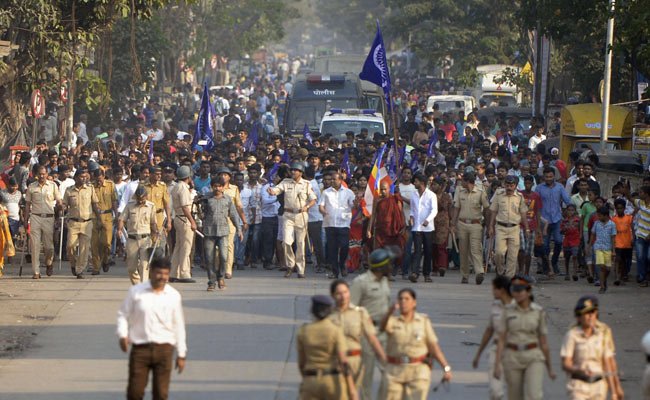Writing this in disappointment and abiding rage, I’m exhausted and empowered at the same time. I’m disappointed since I was introduced to my Dalit history very recently and not in my school, unlike my upper-caste peers, finding no place of mine in the Indian academia.
I was relishing at the idea of subaltern history and celebrating my Dalit assertion in the wake of January 1, Vijay Diwas which was held in Bhima Koregaon in Pune, Maharashtra when my social feed was abruptly filled with news of physical attacks on Dalits who were travelling to celebrate Vijay Diwas on January 1 at Bhima Koregaon, Pune. This came as an un-shockingly brutal and hegemonic reflection of growing saffron terrorism.
Bhima Koregaon’s battle found no place in our academics and popular discourses which implies an existence of a glaring form of academic casteism. The mainstream history celebrated as India’s pride, devoid of the oppressed past is nothing but a biased past and biased history.
On January 1, 1818, while people were celebrating new year, a group of 500 Mahar soldiers (Mahar is a lower caste in Maharashtra) under the British Army were preparing to battle against the Peshwa Army of approximately 30,000 who were eventually defeated in what was called as the Second Anglo-Maratha War by the biased history. The war took place on the banks of the river Bhima which is why the battle is named after Bhima Koregaon. It was said that the war resulted in total destruction of the Peshwa Kingdom and victory of the British Empire in India. But for the Mahar soldiers who fought the battle all alone, it was nothing more than a battle against Peshwa’s upper-caste supremacy. For them, it was the fight for self-respect and dignity against sustained discrimination and violence under the Peshwa rule. It was a historic battle between the Dalits and Manusmriti.
The scenes of saffron masculinity spread over Pune chasing Dalit visitors who came to Bhima Koregaon for celebrating Vijay Diwas is the reflection of fascist casteist hegemony sponsored by the State. Nationalism under the name of saffronisation in the Indian context is imposing homogeneity and silencing the dissenting and emancipatory voices against Manuvad by systematically targeting, attacking and killing minorities.
On the 200th anniversary of Bhima Koregaon, Dalit Bahujans from around the country gathered beside Bhima river 30km away from Pune to pay respects for those who fought the Bhima Koregaon battle on January 1, 1818, and the history of the subaltern that has to be carried by each one of us. Hundreds of Dalit Bahujans had gathered like any other year. But they had to accost abrupt stone pelting from nearby houses who allegedly chanted castiest slurs on the Dalit Bahujan visitors as they took rest on the Bhima riverside.
As the eye witness says, “Men holding saffron flags ride past the Dalit Bahujans who were walking towards the Bhima river while instigating the residents against Dalit Bahujans.” Some of them who were present at the spot said that the fight was initiated owing to a dispute between an upper-caste person and a person belonging to “neechi jaati”. Some of them said to Indian Express that the Marathas had become intolerant to a board that was put up by the Mahar community which said it was the latter who performed the rites of Chatrapathi Sambhaji Maharaj denouncing the falsification of the history by Marathas. The whole phenomena is certainly voicing down the marginalised histories and an attack on counter narratives.
Even if we believe the above instances as a reason for the attack on Dalit Bahujans, it should be appropriate and imperative for us to see this as State sponsored violence on Dalit Bahujans and a constructive war on the voices of the subaltern and not as an isolated incident. This saffron terrorism on the roads of Pune chasing down Dalit Bahujans with blue flags and burning down vehicles is not a surprise form of attack but violence in another shape from tyrannical casteist state.
But the Dalit Bahujan visitors resisted this wave of saffron casteist terror in all ways possible, however, one Dalit man died and many people were attacked physically. This is an attack on our freedom to tell our lived histories by dominant communities who have a strong hold on historic narratives and not a clash between Dalit Bahujans and the upper-caste mob.
In the case of “Maneka Gandhi v. Union of India” (AIR 1978 SC 597) the Supreme Court laid down a golden chain rule to read Article 21, Article 19 and Article 14 of the Constitution together and none of them are exclusive of each other. The freedom of speech guaranteed under Article 19 of the Constitution is the cognitive tool for the substantial functioning of the democracy. When the state fails to protect the Freedom of speech and expression of the citizens it means the state has failed to be democratic.
Hence, this is an attack on democracy and freedom of speech and expression and to silence the counter currents is a mere violation of Article 14, 19 and 21 of the Constitution. Histories need to be democratised and the state should be liable for the violence in Bhima Koregaon.
Also read: Why Manusmriti Dahan Din Is Still Relevant
Featured Image Credit: NDTV
About the author(s)
Sanjeev is a law student and Dalit Queer Feminist





Wasn’t it a Maratha bystander who died?